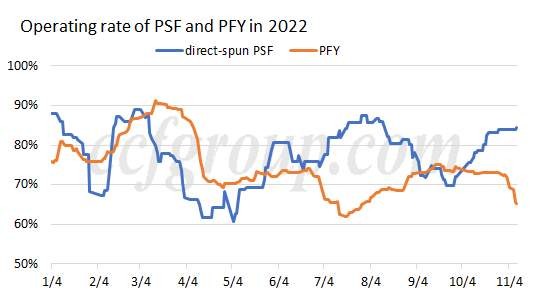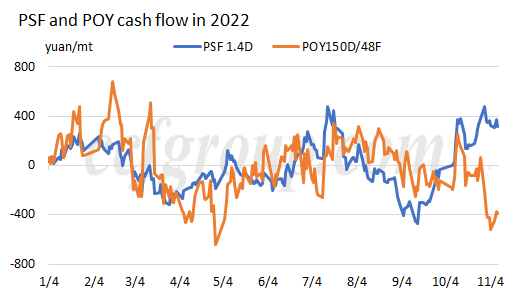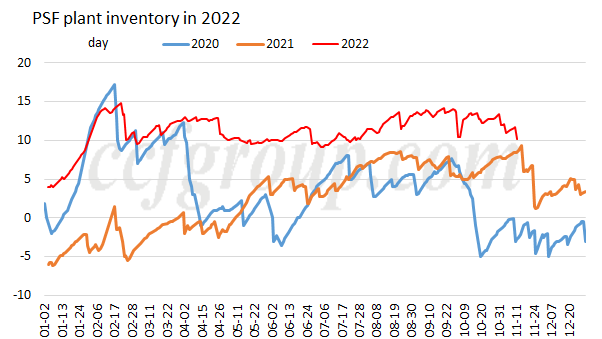PSF: how long will the high PSF spread sustain?
Since Oct, direct-spun PSF performance is eye-catching with profits and more than 80% of plant operating rate, and it is a star product compared with PFY and polyester yarn.

Take a review of two periods of high PSF spread. One is during Jun-Aug, after long period of plant shutdown, another is the period since Oct, after product cut during Aug-Sep. Normally, the process of “production cut-tight spot supply-profit improved” is closely linked, and the product cut has good stimulus for PSF spread. But the improvement of PSF spread is always delayed after product cut. The route reason is the volumes of cargos held by spot-futures traders drag down the market prices, so producers cannot sell at high level. In addition, the delayed time largely depends on the volumes of cargos held by traders. It can be obviously seen during Mar-Aug, 2021. During the half of the year, PSF plants had low discursive power to market prices. PSF spread kept low and sales sustained bleak. Till the volumes of cargos held by traders were sold out, the discursive power for PSF plants returned. After that, plants draw a lesson and are cautious to sell products to spot-futures traders. The good PSF spread is closely linked with the discursive power of PSF plants currently.

Essentially, the degree of marketization of PSF is not enough, the geographical location of the plants, brand price spread, downstream dispersion and other barriers limit the participation of upstream and downstream enterprises in futures. The listing time of PSF futures is not long enough, it still takes time to develop and perfect.

Of course, the higher discursive power to market prices of PSF plants does not mean the sustained profits. From the perspective of demand, demand weakens quickly since Oct with the multiple outbreaks of epidemic in many regions. Operating rate of spinning mills in Hebei reduced fast last week with epidemic-related control measures and some spinners cut more production or suspended for holiday. In general, demand is weakening. Since Nov, PSF Dec contract has risen by about 400yuan/mt and spot PSF prices lowered by 100yuan/mt, the price spread between spot PSF and PSF futures narrowed. Currently, PSF plant inventory is about 10 days, higher than last year, but tolerable. Viewed from supply and demand, the support to PSF is basically neutral, and inventory is supposed to accumulate.
The changes of feedstock market continue. Oil prices go firmer. On one hand, OPEC is expected to cut production. On the other hand, market players worry about global economic downtrend and weak demand. Under such condition, oil market seesaws. On Nov 10, U.S. released its Oct CPI, which was significantly lower than market anticipation. U.S. stocks and commodity moved up. Polyester feedstock market also bolstered by arbitrage from Asia to US. Spot PSF prices stopped decreasing. On last Friday, the State Council's Joint Prevention and Control Mechanism released 20 measures aimed at optimizing disease control measures, which laid out changes ranging from quarantine periods for inbound visitors to designation of risky regions and contacts. PSF sales improved, with sales ratio averaged at 170%, while PFY sales ratio only averaged at 60%, and polyester yarn market saw no improvement. On one hand, PSF got support from futures market. On the other hand, the downstream application of PFY and spinning mills was similar, and fabric mills paid more attention to own orders, and under high inventory and inadequate orders, they lacked interests to replenish feedstock.
PSF inventory accumulation is expected to be delayed and producers are more willing to hold firm attitude on prices. Then, the high PSF spread gains more stimulus to sustain high.
- Top keywords
- Cotton Price
- Cotton Futures Price
- Cotton Futures
- CZCE
- PTA Futures Price
- Chemical Fiber
- Polyester Prices
- Wool price
- PTA Futures
- Shengze Silk
- China
- Yarn Price
- price
- China Textile City
- Fibre Price
- Benzene Price
- Cotton
- Index
- Cotton Index
- PTA
- fabric price
- NYMEX
- Top 10
- textile industry
- Spot Cotton
- Cotton Yarn
- Polyester Price
- Futures
- PTA Price
- cotton yarn price

